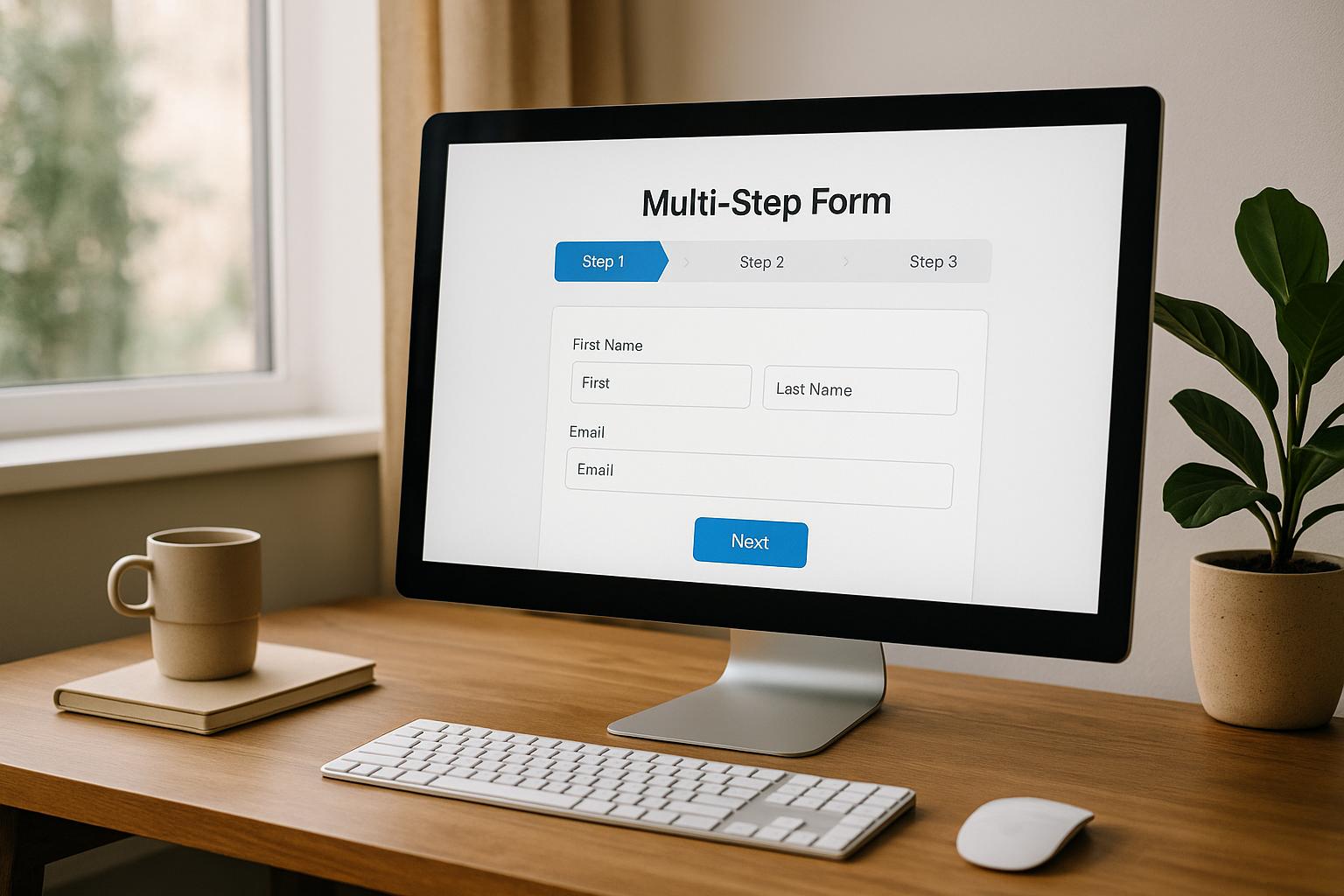Guessing wastes time and money. Data delivers results.
- 78% of companies say data improves lead conversion and customer acquisition.
- 74% of customers get frustrated by irrelevant content caused by guesswork.
- Data-driven strategies achieve up to 5× higher conversion rates compared to guessing.
Why Data Is Better Than Guesswork:
- Audience Research: Tools like surveys, web analytics, and social media insights reveal what your audience truly wants.
- Guesswork: Relies on assumptions, leading to irrelevant content, missed opportunities, and wasted marketing dollars.
Benefits of Data-Driven Marketing:
- Higher ROI: Companies using data see 20% higher returns.
- Personalization: Targeted lead magnets convert 20–25% of users, compared to generic ones.
- Better Decisions: 59% of marketers say data helps them act faster and smarter.
Quick Comparison:
| Aspect | Audience Research | Guesswork |
|---|---|---|
| Foundation | Real data and insights | Assumptions and intuition |
| Targeting | Accurate and specific | Broad and generic |
| Conversion Rates | 20–25% with targeted efforts | Much lower, around 1–5% |
| Efficiency | Reduced waste, better ROI | High waste, poor ROI |
| Personalization | Tailored content resonates | Irrelevant content frustrates |
Bottom Line: Guessing leads to missed opportunities. Data ensures your marketing hits the mark, saves resources, and drives better results.
Going Broad? Why Audience Clarity Matters More Than Ever
What Is Audience Research?
Audience research is all about digging deep into the people you want to connect with through your marketing. Unlike broader market research that looks at industry trends or competitor pricing, this type of research zeroes in on your actual audience - their attitudes, behaviors, and preferences. It helps answer key questions like: What captures their interest? Who influences their decisions? What obstacles are they facing? How do they feel about existing solutions in the market? These insights lay the groundwork for creating lead magnets that actually work.
To get these insights, you need to use the right research methods. Let’s take a closer look at the tools that help marketers truly understand their audience.
Research Methods and Data Sources
A well-rounded audience research strategy blends different methods, each offering unique insights into your target audience:
-
Surveys and Questionnaires
These tools are great for gathering both numbers-driven data and open-ended feedback. -
Focus Groups and In-Depth Interviews
These methods go beyond surface-level responses, uncovering motivations that surveys might miss. -
Social Media Analytics
Platforms like Instagram and X (formerly Twitter) provide real-time insights into what your audience cares about and how they feel. -
Web Analytics
Tools like Google Analytics show which content grabs attention, helping refine your strategy. -
Ethnographic Research
Observing people in their natural environments can reveal behaviors and needs that might otherwise go unnoticed. -
User Testing and Usability Studies
These highlight friction points in your user experience that could be hurting conversions. -
Big Data and Predictive Analytics
Analyzing large datasets enables personalized recommendations and helps improve customer retention.
Why Audience Research Matters
Audience research takes the guesswork out of marketing by giving you the data you need to act with purpose. When you understand what makes your audience tick, you can create lead magnets that solve their real problems instead of relying on assumptions.
Lead magnets tailored to specific audience needs consistently outperform generic ones. In fact, some industries see conversion rates as high as 20-25% when using targeted lead magnets. For example, a checklist or audit that addresses a clear pain point can be far more compelling than a vague freebie.
This kind of research also helps avoid common mistakes. A lead magnet that’s too broad won’t resonate, and one that misses the mark entirely won’t engage anyone. A great example comes from Snow Monkey, a company that added a zip-code field to their lead capture form. This simple change aligned their e-commerce strategy with local customer needs, leading to a five-fold increase in their email database.
As Vincent Bucciachio, Founder of SociallyInfused, explains:
"When it comes to lead magnets, marketers tend to forget that there's a difference between a magnet that you consider valuable and one that your specific target market considers valuable. They are not the same thing."
This is why audience research is so powerful - it ensures your efforts are grounded in what your audience actually wants, not just what you think they want.
The Problems with Guesswork in Marketing
Relying on assumptions instead of data is a risky move in marketing. The stakes are high, and the numbers paint a concerning picture: 60–75% of marketers admit their teams depend on guesswork when making decisions. This habit can derail even the most well-meaning campaigns, wasting time, money, and effort.
At its core, the problem is straightforward but expensive. As Jeremy King, CEO and Founder of Attest, explains:
"Whether a brand is handling the backlash from a high-profile controversy, adjusting prices due to inflation or strategizing on how best to reach their next wave of growth, you can easily trace the biggest PR, advertising and product disasters back to one simple fact: instead of doing their research, brands made big calls based on guesswork."
In a market that's constantly evolving, guesswork becomes even more dangerous. For example, 88% of consumers are experimenting with new products and services due to rising costs. When consumer behavior shifts, relying on outdated assumptions can lead to poor decisions. These challenges highlight why guesswork in marketing is a recipe for trouble.
Common Problems with Assumption-Based Marketing
One of the most obvious issues is generic messaging. Without solid audience insights, marketers often create vague, one-size-fits-all content that fails to connect. Tim Davidson, Founder of B2B Rizz, puts it bluntly:
"If everyone is your market, you are no one to the market."
Another issue is choosing the wrong channels. Guessing where to focus efforts can lead to wasted time and money on platforms where the target audience isn’t even active.
Then there’s the lack of personalization, which alienates consumers who now expect tailored experiences. When campaigns feel irrelevant, engagement drops.
Perhaps the most damaging problem is sticking to initial assumptions despite clear signs of failure. This stubbornness leads to stagnation and continued resource loss. Considering that marketing can take up as much as 30% of a business owner's time, wasting those hours on ineffective campaigns is a costly mistake.
Case Study: When Guesswork Goes Wrong
Take the example of a financial advisor trying to reach pre-retirees, young professionals, and high-net-worth individuals. Assuming that a single message about "financial security" would resonate with all these groups, the advisor sends out generic communications. But here’s the problem:
- Pre-retirees care about preserving their wealth.
- Young professionals are focused on managing debt.
- High-net-worth individuals prioritize tax strategies and estate planning.
A generic approach misses the mark for every segment. Engagement plummets, and conversion rates follow. The campaign fails to generate quality leads because it didn’t address the unique concerns of each audience.
Personal bias adds another layer of risk. Jeremy King cautions:
"Personal bias can derail even the greatest of experiments, resulting in massive, costly mistakes and error-filled conclusions."
When marketers rely on gut feelings, they often create campaigns or lead magnets that don’t align with their audience’s needs. This disconnect is where assumption-based marketing ultimately falls apart, leaving brands with poor results and wasted resources.
sbb-itb-f031672
The Benefits of Data-Driven Audience Research
When it comes to tackling the challenges of guesswork in marketing, data-driven research offers a clear path forward. By turning audience insights into actionable strategies, data takes the uncertainty out of decision-making. In fact, companies that rely on data are 6× more profitable, 23× more likely to acquire customers, and 6× more likely to retain them. With deep insights, every marketing dollar works harder.
Why Data-Driven Marketing Works
Data eliminates the need for assumptions, giving businesses precise insights into their audience. Instead of casting a wide net, marketers can pinpoint their ideal customers, ensuring resources are spent wisely and ROI improves.
One standout advantage is scalable personalization. Research shows that 80% of consumers engage more with brands offering tailored content, and 79% of customers ignore offers that aren't personalized to their past interactions. It’s clear: personalization isn’t just a nice touch - it’s essential.
Real-world examples highlight the power of data-driven strategies:
-
ComplyAdvantage boosted its conversion rate by 15% and cut its email bounce rate to 6%. Jonny Fianu, the company’s Global Head of Revenue Operations, puts it succinctly:
"Having high-quality data is not a nice to have. It's a must-have."
- JOMA Packaging increased lead volumes by 30–40% while achieving ROI within the first year.
- Plandek improved its data quality and enrichment by 85%, maintaining a 95% email deliverability rate.
These results aren’t anomalies. Businesses leveraging personalization see 5–8 times higher ROI on marketing efforts, and 78% of organizations report increased lead conversion and customer acquisition through data-driven methods. It’s clear that data not only drives results but also shapes more effective lead generation strategies.
How Research Enhances Lead Magnet Performance
Data-driven strategies don’t just improve marketing - they transform lead generation. Targeted lead magnets, crafted with research-backed insights, consistently outperform generic ones. In some industries, the most effective lead magnets achieve conversion rates of 20–25%.
Take these examples:
- A coaching firm replaced a generic PDF with an interactive Business Growth Calculator, seeing higher conversion rates and better-quality leads.
- A digital marketing agency swapped a lengthy eBook for a 5-Day Email Course packed with actionable lessons.
- A freelance writer found success with a Client Onboarding Template Pack, featuring customizable questionnaires and process documents.
Research also sharpens lead scoring by quantifying customer actions. When lead magnets align with customer preferences - whether that’s interactive tools, templates, or guides - they naturally attract better prospects. It’s no surprise that 50% of marketers report higher conversion rates when using lead magnets.
For more strategies and tips on using data to supercharge your lead magnets, check out HL Max at https://hlmax.co.
Audience Research vs. Guesswork: Side-by-Side Comparison
Relying on data-driven strategies delivers outcomes that far surpass those achieved through guesswork. While guessing might seem faster, it often comes with hefty financial and strategic consequences in the long run.
Campaigns built on assumptions tend to waste marketing dollars, producing off-target content and low conversion rates. On the other hand, businesses that invest in audience research see measurable improvements across critical metrics. For instance, data-driven approaches not only enhance customer acquisition and retention but also enable more effective lead magnet strategies. In fact, companies using these methods report five to eight times higher ROI, clearly showcasing the value of research-backed decisions.
Moreover, research-based marketing provides a solid foundation for sustained growth. Instead of constantly chasing new directions based on hunches, teams can rely on proven insights to confidently refine their strategies.
Comparison Table: Data vs. Guesswork
The differences between audience research and guesswork become particularly striking when compared directly:
| Aspect | Audience Research | Guesswork |
|---|---|---|
| Decision Foundation | Real customer data, behavioral patterns, and verified insights | Assumptions, stereotypes, and intuition |
| Targeting Accuracy | Precise audience segments based on actual demographics and behaviors | Broad, generalized targeting that may miss the mark |
| Content Relevance | 80% of customers are more likely to purchase from a brand offering personalized, research-backed content | Generic content that often fails to resonate |
| Conversion Performance | 20–25% conversion rates achievable with targeted lead magnets | Significantly lower conversion rates due to misalignment |
| Marketing Spend Efficiency | 30% reduction in marketing spend wastage through statistical analysis | Higher waste due to ineffective targeting and messaging |
| Campaign Performance | 35% boost in campaign performance through segmentation strategies | Inconsistent results with frequent campaign failures |
| ROI Outcomes | 20% higher ROI compared to traditional approaches | Lower returns due to a trial-and-error approach |
| Risk Level | Lower risk through validated insights and continuous testing | High risk of costly mistakes and brand misalignment |
| Scalability | Scalable strategies built on proven data foundations | Difficult to scale without reliable performance indicators |
| Customer Understanding | Deep insights into customer motivations, pain points, and preferences | Shallow assumptions that misread needs |
This table highlights the stark contrast between the two approaches. Businesses leveraging data-driven strategies often achieve a 20% increase in ROI compared to traditional methods. By focusing on genuine audience needs, these strategies maximize efficiency and effectiveness.
When marketers use data to truly understand their audience, they create lead magnets that solve real problems and deliver tangible results. These messages resonate because they address specific customer pain points, rather than relying on generic or overly broad propositions.
In contrast, assumption-based marketing frequently falls short. Without objective data or user feedback, marketers risk misunderstanding their audience’s needs. This can lead to campaigns that waste resources and damage brand credibility.
Data-driven personalization, supported by predictive analytics, has been shown to double the likelihood of achieving revenue goals. It consistently outperforms guess-based methods, making it clear why smart marketers view audience research as the cornerstone of a scalable and sustainable marketing strategy. Without it, even the most creative campaigns can become costly experiments. By integrating research into their strategies, marketers not only refine targeting but also lay the groundwork for long-term success.
Conclusion: Why Data Wins
The facts speak for themselves: relying on data-driven audience research consistently outperforms guesswork across all major marketing metrics. Sure, making assumptions might seem quicker, but it often leads to wasted budgets, missed opportunities, and campaigns that fall flat with your audience.
Companies that embrace data-driven strategies see returns that are 5 to 8 times higher compared to intuition-based methods - proof that informed decisions lead to real results. On top of that, 79% of customers won't even consider an offer unless it's tailored to their past interactions. These numbers make it clear: guesswork doesn’t cut it in today’s competitive market.
Data isn’t just about numbers - it’s a game-changer. It turns generic lead magnets into targeted tools that convert. It replaces assumptions with actionable insights into what your customers actually want. This not only boosts conversion rates but also builds trust and positions your brand as one that genuinely understands its audience.
Adopting a research-driven approach requires practical tools like analytics, segmentation techniques, and constant testing. While 81% of marketers admit that data-driven strategies can feel complex, the payoff is undeniable - better targeting, improved conversion rates, and smarter use of your marketing budget.
That’s where HL Max comes in. With our educational resources and step-by-step guidance, marketers can confidently navigate the world of data-driven audience research. From tutorials to actionable strategies, we provide the tools you need to leave guesswork behind.
Ultimately, choosing data over guesswork isn’t just about better campaign performance - it’s about creating a marketing system that grows stronger and more efficient over time. By grounding your efforts in research and genuine audience understanding, every campaign strengthens customer relationships and drives meaningful business growth. This approach enhances every stage of the marketing funnel, ensuring long-term success.
FAQs
How can businesses move from relying on assumptions to using data for smarter marketing decisions?
To move from guesswork to informed, data-driven marketing, businesses need to start by implementing tools that gather and analyze customer data. Platforms like Google Analytics or CRM systems can reveal valuable insights into customer behavior, preferences, and engagement trends. This enables businesses to base their decisions on measurable data rather than relying on intuition.
Once the data is in place, the next step is audience segmentation. By breaking your audience into distinct groups based on their specific needs or behaviors, you can craft personalized marketing campaigns that connect more deeply with each segment. This tailored approach not only boosts engagement but also improves your return on investment. A strategy rooted in data ensures that marketing efforts are directed toward areas with the most impact, maximizing both efficiency and results.
What mistakes do businesses make when relying on guesswork instead of audience research?
When businesses skip audience research and rely on guesswork, they often end up making expensive missteps. One major issue is not identifying or clearly defining their target audience. This oversight leads to broad, unfocused marketing strategies that fail to resonate with the right people. The result? Wasted time, money, and missed chances to connect with potential customers in a meaningful way.
Another common pitfall is ignoring data and analytics. Relying on assumptions instead of actual customer insights can derail campaigns, produce poor returns on investment, and leave businesses without the tools to improve future efforts. In contrast, using data to guide decisions ensures marketing strategies are targeted and effective, turning guesswork into measurable success.
What are the best tools and methods for effective audience research?
To truly understand your audience, it's important to use a combination of methods and tools that provide both broad data and deeper insights. Surveys and questionnaires can help you gather a wide range of information, while interviews and focus groups allow you to dig into the "why" behind their choices and preferences. Pair these with social media and website analytics to uncover patterns in behavior and engagement.
When it comes to tools, Google Analytics is a go-to for tracking website activity, while Facebook Audience Insights can reveal trends on social media. Survey platforms are also invaluable for gathering specific feedback. By weaving together these methods, you’ll gain a clearer picture of your audience, allowing you to craft marketing strategies that truly resonate.



